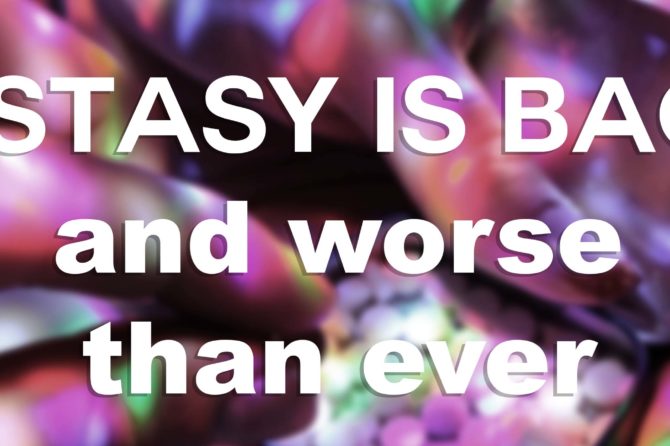
Ecstasy is Back and It’s Worse Than Ever
MDMA – also known as Ecstasy or Molly – is on the rise. In fact, deaths from the drug are at their highest level in a decade. According to Vice, Fiona Measham, a professor of criminology, the average strength of an MDMA pill in 2014 was 100mg, much stronger than the average of 20-30mg in 2009. It’s not just the strength of the drug that’s increasing either – it’s the deaths associated with it.
According to the National Institute on Drug Abuse, MDMA is “a synthetic drug that alters mood and perception (awareness of surrounding objects and conditions). It is chemically similar to both stimulants and hallucinogens, producing feelings of increased energy, pleasure, emotional warmth, and distorted sensory and time perception.”
MDMA is usually taken in capsule or tablet form although it can also be swallowed or snorted, depending on its form. The nickname Molly is slang for ‘molecular’ – but often times Molly is made up of other, far more dangerous drugs such as synthetic cathinones – also known as Bath Salts.
The appeal from the drug is obvious; it increases the activity found in three separate brain chemicals – Dopamine, Norepinephrine, and Serotonin. Ultimately, that means a surge in heart rate, blood pressure, euphoria, sexual arousal, empathy, and trust.
Making things much worse is the arrival of the “super pills”, some of which are made with a staggering 270-340mg – and, while billed as Ecstasy, oftentimes don’t even contain MDMA. According to Vice, a girl died after taking what she thought was a “Mastercard ecstasy pill” but which turned out to be made with PMA, which – while delivering a similar feeling to Molly – is actually highly toxic. It becomes even deadlier when mixed with other drugs such as cocaine or MDMA.
How bad is MDMA use getting? According to the National Institute on Drug Abuse, “in 2014 more than 17 million persons aged 12 or older reported using MDMA at least once in their lifetimes. This is an increase from 11 million reported 10 years prior.”
And it does not stop there. In the Monitoring the Future survey (the NIDA’s yearly survey on teen drug use, taken in 2016) found that “past-year MDMA use was reported by 2.7 percent of 12th graders, 1.8 percent of 10th graders, and one percent of 8th graders.”
The surge in bad ecstasy isn’t limited to America. In Wellington, New Zealand, experts are urging that their huge music festival, Homegrown, provide testing facilities to screen for a lethal drug being sold as ecstasy.
According to RadioNZ, N-Ethylpentylone – which is also known as Bath Salts – is being passed off as MDMA but in reality, it’s three times as strong. Wendy Allison, director of Know Your Stuff NZ, attends music festivals and shows people how to test drugs so they know what they’re taking. “Without that testing, people are taking this stuff, they think it’s MDMA and as the hospitalizations in Christchurch identified it is not the same as MDMA and potentially much more harmful,” she said.
MDMA by itself is harmful enough. While the effects last from three to six hours, many users take a second dose when they feel the initial effects are beginning to fade. According to the NIH, health effects include:
- nausea
- muscle cramping
- involuntary teeth clenching
- blurred vision
- chills
- sweating
Over the course of the week following moderate use of the drug, a person may experience:
- irritability
- impulsiveness and aggression
- depression
- sleep problems
- anxiety
- memory and attention problems
- decreased appetite
- decreased interest in and pleasure from sex
And that’s without the added dangers of a drug that’s cut or mixed with something far, far worse.
So how can you prevent the use of MDMA? It’s not that easy. According to the NIH, education is the best – and in many cases – the only way forward. “Providing accurate scientific information regarding the effects of MDMA is important for reducing the negative health effects associated with the use of this drug. Young adults who use MDMA report that friends, substance use disorder treatment programs, and physicians are their most trusted sources of information about MDMA. Many also report that the Internet is an important source of information, suggesting that prevention websites should be designed to be responsive to the needs of this population.”
The next best steps are ways to reduce or mitigate the effects of MDMA. According to Alternet, there are seven ways to do that:
- Be Aware Of What You’re Taking
- Replenish the body’s supply of neurotransmitters.
- Fight oxidative stress.
- Drink plenty of liquids, especially fresh juices, but not alcohol.
- Eat well.
- Sleep.
- Do less MDMA, less often.
Of course, the perfect situation means living without any form of MDMA. And for that, a healthy diet is suggested to go along with a healthy state of mind. As Windward Way puts it, “a healthy diet with essential vitamins and minerals – such as amino acids – can help maintain sobriety and a good mindset.”
Leave a reply